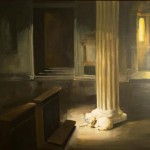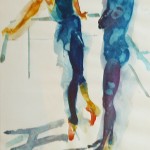Biography
Eric Fischl (born 1948)
Born in New York City in 1948, Fischl grew up, one of four children, in the suburban Long Island community of Port Washington. His father was a salesman, his mother a housewife who was also an alcoholic. He spent a brief period as a flower child in San Francisco. His interest in art began in 1968 when he worked in Phoenix, Arizona delivering patio furniture and became friends with a fellow truck driver who was attending art school. Fischl attended Junior College and then Arizona State University where he studied with Bill Swain who encouraged him to apply to CalArts. He earned a Bachelor of Fine Arts degree from the California Institute of Arts at Valencia, California in 1972 and became an assistant professor of Nova Scotia College of Art and Design in Halifax from 1974 to 1978. He also returned to the California Institute of Art to teach art and later established a studio in New York City. His relationship with April Gornik began when he was teaching in Nova Scotia and in 1978 they moved to New York City where they lived in Greenwich Village with separate studios in SoHo. In 1988 they spent some time in India.
Fischl is a painter of startling candor. He is a natural storyteller in paint and his willingness to catch private moments with chilling clarity and then talk about what he is up to without a hint of embarassment is perhaps his most singular quality. He explores the pyschosocial scene through the use of taboo subject matter such as themes of sexuality, often capturing figures in self-conscious and awkward moments. He does not work with live models, but instead takes polaroid pictures, of nudes if possible, and uses these pictures as his models, putting them into backgrounds that tell a story.
Fischl is usually categorized as a Neo-Expressionist, but that label seems to have been applied more for convenience than accuracy. He is closer to the realist tradition, but with important qualifications. Far from being subversive or unanchored, his unidealized vision fits into a tradition of dissecting the harshness and materialism of American life, a tradition that takes in artists from Eakins and Hopper to George Tooker, Paul Cadmus and Gregory Gillespie. Fascinated with the banal and sordid, Fischl updates the American scene, monitoring the stresses and fears of the eighties. Many affinities bind Fischl and Hopper; the blistering light, the desire to show how people act when they think they are alone or not observed, and the creation of a disquieting atmosphere.

 Dog in God House
Dog in God House
 Denver Dancers
Denver Dancers